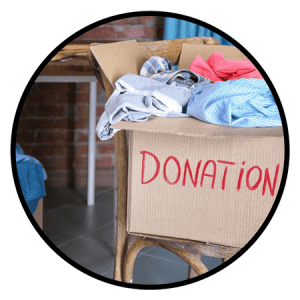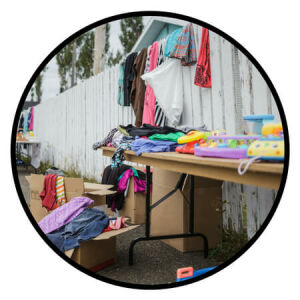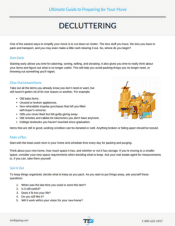One of the easiest ways of organizing for a move is to cut down on clutter. The less stuff you have, the less you have to pack and transport, and you can even make a little cash clearing it out at a garage sale.
So where do you begin?
|
Jump to: |
1. Start early
As soon as you learn you’re moving, it’s time to get to work on decluttering. This is not something you want to procrastinate, because otherwise you’ll end up having to pack everything and you may never cut down on things, or worse - you may accidentally throw out something you’ll regret.
Starting early allows you time for planning, sorting, selling, and donating. There are lots of different methods for decluttering before a move, so you’re sure to find a system that works for you. If you're moving with kids, starting early also gives you time to break the news about the move. If they are old enough, you'll also have time to get them involved in the decluttering process.
Kyle Hiscock notes that de-cluttering is also an important part of making your home appealing to prospective buyers:
A home that’s decluttered and has things neatly organized in boxes or bins shows much better than a home with stuff everywhere.
2. Clear out unused items
Before you start sorting and decluttering, take out all the items you already know you don’t need or want, but still haven’t gotten rid of for one reason or another. For example:
- Old baby items.
- Unused or broken appliances.
- Non-refundable impulse purchases that left you filled with buyer’s remorse.
- Gifts you never liked but felt guilty giving away. (Bonus: now you have a built-in excuse—it got lost in the move!)
- Old remotes and cables for electronics you don’t even have anymore.
- College textbooks you haven’t touched since graduation.
|
If you aren't moving but want to organize your home, decluttering is the first step. Get organized with our guides: |
Items that are still in good, working condition can be donated or sold, but anything broken or falling apart should be tossed.
3. Make a plan
Factor your decluttering efforts into your packing plan. Start with the least-used room in your home and schedule time every day for packing and purging, even if you only have time for a single area. Think about your new home, how much space it has, whether it is bigger or smaller than your current place, and whether or not it has storage.
If you’re moving to a smaller space, you’ll have to consider your new space requirements when making choices about what to keep. There might not be room for everything, so figure out what items, furniture, and appliances you will need. Ask your real estate agent for measurements or, if you can, take them yourself. There’s no point moving two couches if one of them won’t fit in the space you want it for.
| PRO TIP: When you’re downsizing, pack items into “keep”, “maybe”, and “toss” boxes. In the event that you don’t have enough space for everything, it’s simple to transport the “maybe” boxes to storage or donate them rather than trying to figure out what to get rid of when you’re unpacking. |
4. Sort it out
Now that you’ve got a plan and have chucked anything unusable, you can start to sort what remains. To keep things organized, decide what to keep as you pack. As you start to put things away, ask yourself these questions:

With these questions in mind, create four piles:
- Keep - anything that is used, still useable, or has a purpose. And don’t forget anything that still makes you happy or feels significant. Items don’t necessarily have to be useful or used regularly to be worth keeping.
- Sell - items that are in good condition can be sold at a garage sale, on websites such as Craigslist or Facebook Marketplace, or at consignment shops. Keep reading for our tips on selling your stuff.
- Donate - anything that isn’t worth selling, but is still in good enough condition to wear or use should be donated.
- Recycle - take anything damaged, worn out, or unusable to your local dump or recycling place for sorting. Items like electronics should be disposed of properly, and most recycling centers have a spot for them.
| PRO TIP: Make sure to wipe any personal information from electronic devices before selling, donating, or disposing of them. |
5. Go digital
One of the easiest ways to cut down on clutter is to digitize anything that you don’t need a physical copy of, such as:
- Photographs
- Home movies
- Files
These things can be easily scanned or transferred to your computer for safekeeping. Keep physical copies of any images you feel especially attached to or plan to frame, as well as any paperwork you may need to retain for tax or legal reasons, but digitize the rest. Not only does this save you space, it might also be saving your memories. Old VHS tapes and slides aren’t built to last, so they are actually physically degrading and will eventually be lost if you don’t take steps to preserve them.
| PRO TIP: Remember to back up anything you digitize to an external hard drive or USB stick. |
6. Get help
Not only does having helping hands make it faster and easier to pack up your stuff, but when you're decluttering before a move, they can also offer you objective points of view when it comes to items you’re not sure about. Plus, packing with a pal is more fun and your stuff might find a new loving home with a friend.
Hiring movers to help with loading your belongings will leave you with more time and energy to devote to decluttering, and will also make it easier to move any large or bulky items you decide to hang on to.
7. Don’t forget
With so much going on, it’s easy to overlook certain areas, especially ones that aren’t used often. Make sure to check these places while you’re packing up:
- Medicine cabinet - take everything out of your medicine cabinet and safely dispose of anything expired or that you no longer need. Prescriptions and some over-the-counter pills should not be thrown in the garbage or flushed down the toilet. Do a little research to find out the best way to dispose of your old prescriptions, or take them back to your pharmacy or to a local pharmacist if possible. Some police stations also have prescription drop boxes.
- Pantry - discard anything expired or that you don’t eat anymore. Diets, tastes, and allergies change over time, so don’t hold on to anything you know you aren’t going to use in the time left in your current home. If the food isn’t expired and is still in a sealed package, consider donating it to a local shelter or food bank. This is also a good time to sort through your cooking utensils and get rid of any unnecessary extras.
- Attic or Crawl Space - these spaces are usually a great out-of-the-way spot for storage, but that can also mean they become a dumping ground for anything you don’t use anymore. Don’t stick the new residents with your old chairs. Make sure to check these spots for any items you might have forgotten about.
8. Selling your stuff
After you’ve finished figuring out what you no longer want or need, you can start getting rid of it. If it’s in good condition, you can recoup some of your moving costs by selling some of it. There are a few different methods for unloading your old belongings:

Yard Sale
Yard sales are a time-honored summer tradition and great way to get rid of your stuff. With proper planning, you may even be able to get rid of most of your items in a single day. There are three keys to yard sale success:
- Timing - Yard sales are best held in nice weather in spring or summer, when people are most likely to be out and about. Weekends and holidays when the majority of people will have time off from work are ideal.
- Location - Hold your yard sale somewhere prominent and easy to access. If your house is deep inside your subdivision or you live in an apartment, see if you can borrow a friend or family member’s yard.
- Advertising - Promote your yard sale early and often. Don’t just promote using flyers either! Create a Facebook event and post it in neighborhood and city groups, and ask friends to share it. Entice people to attend with advanced notice and information about some of the better items available.
Online
If you don’t feel up to hosting a garage sale, you can always turn to the internet. Depending on what you have to get rid of, there are many sites to choose from:
- For books, toys, furniture, collectibles, antiques, and knick knacks, try Ebay, Craigslist and Facebook Marketplace.
- If you have a lot of clothes to unload, try Poshmark, thredUP, or Tradesy.
To ensure your stuff gets sold, you’ll need to list it properly. Try these tips:
- Pricing - Don’t be unrealistic about the value of the item. Find out how much a brand new item costs, check what other people are selling it for, and keep the condition of the item in mind. Even in great condition, it probably isn’t worth what you originally paid now that it’s been used, unless it’s a highly-prized collectible. Expect that some buyers will want to haggle and negotiate the price.
- Cleaning - Clean the item thoroughly and, if possible, repair any damage.
|
The easiest items to sell include:
|
- Description - Include key details, special features, and brand information. Be descriptive and honest about the condition, and include good quality photos of the item from different angles, with detailed shots of any damaged or flawed spots. If you’re listing clothes, try to include an image of someone wearing the garment - people will be interested in seeing how it fits.
- Delivery - Some websites offer to ship items for you, but if you anticipate having to ship the item, try to build that into the price. For large items, you’re better off selling locally and including buyer pickup as part of the condition of sale, unless you have the means to deliver it.
Consignment
If you’d rather not deal with the hassle of selling your stuff at all and you’re staying nearby or can set up an arrangement, you can take any items that are in good condition to a local consignment shop where they will be sold for you. The shop will take a commission, but you won’t have to do anything except drop it off.
Download our Printable GuideClick to download (PDF)
Download the complete printable Ultimate Guide to Preparing for Your Move. |
Keep Reading the Ultimate Guide to Preparing for Your MovePart 1: Budgeting for Your Move Part 7: Moving Large, Heavy, or Bulky Items |

